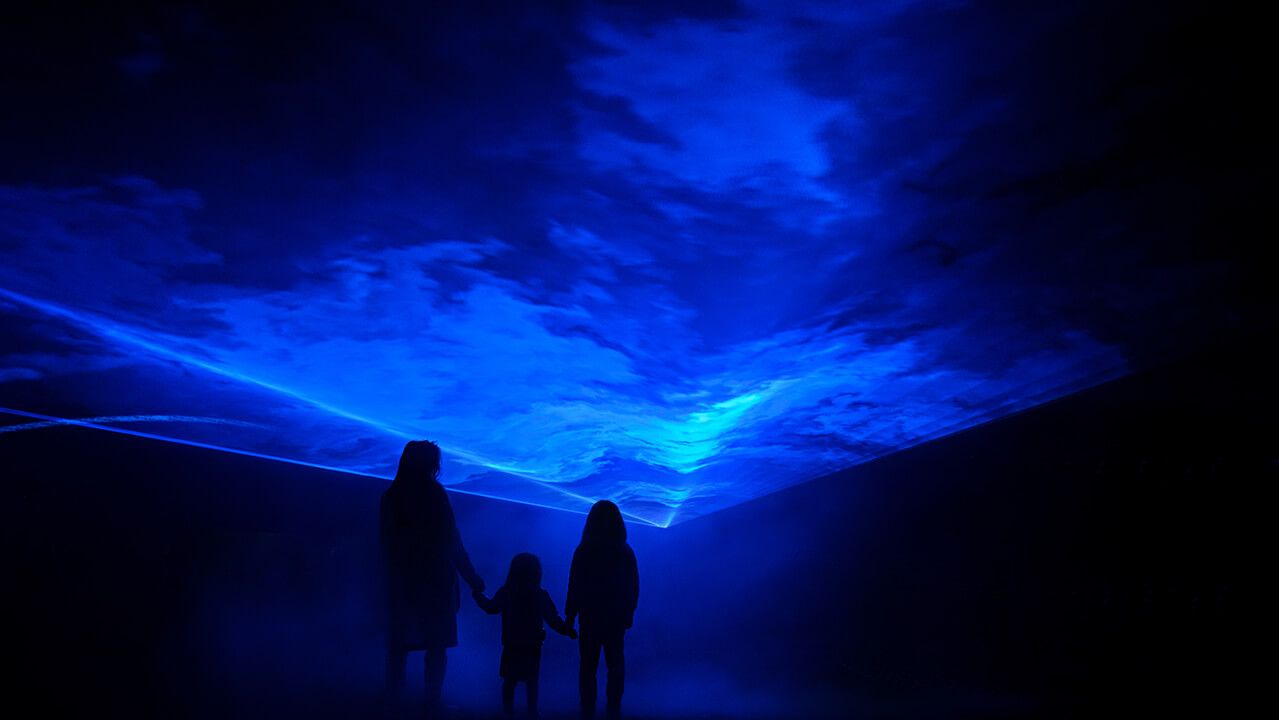Today, I have the pleasure of speaking with Daan Roosegaarde from Studio Roosegaarde and Cassie Greatens from CASS Contemporary. Daan Roosegaarde is a renowned artist known for his innovative installations, while Cassie Greatens represents an art consulting firm specializing in public art installations. We’re going to discuss their collaborative project showcasing Waterlicht and Dune in Tampa, and its impact on communities and the future of art in smart cities.
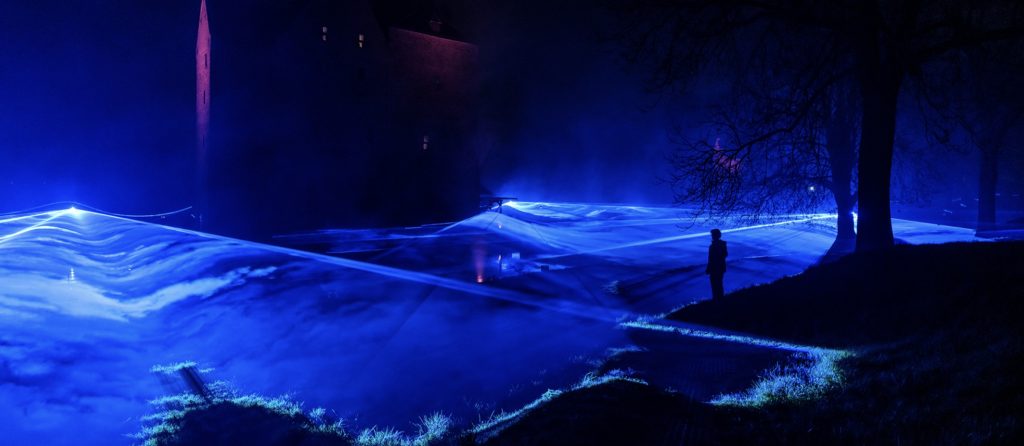
Studio Roosegaarde, Waterlicht, 2015, various locations. Studio Roosegaarde.
Agnieszka Cichocka: Daan, could you tell us more about the Waterlicht project and what inspired you to focus on the subject of water?
Daan Roosegaarde: Waterlicht is an immersive light art installation that uses LEDs and lenses to create the illusion of waves of water in the air. The project was inspired by my upbringing in the Netherlands, a country where water has played a significant role for centuries. Living below sea level, we’ve developed intricate systems to manage and live alongside water. Water is an essential part of our landscape and culture, and I wanted to create an artwork that raises awareness about its beauty and importance. Water is always present in the Dutch landscape, shaping our lives and influencing our understanding of coexistence with it. Even as a child, I wasn’t allowed to play outside without my swimming diploma due to the omnipresence of water. The landscape I grew up in, where I built my dreams and aspirations, is fundamentally tied to water. This relationship with water has instilled in us a profound respect and understanding of its significance.
Waterlicht uses a dreamscape environment to simulate the feeling of being underwater. It achieves this through a combination of LED lighting, software, lenses, and humidity, all working together to create an awe-inspiring experience. This particular installation has been displayed in multiple venues across Europe, as well as at the United Nations Headquarters and Columbia University in New York, drawing hundreds of thousands of spectators. Waterlicht on Water Street in Tampa is a significant extension of this vision, marrying the rich history of the Netherlands’ relationship with water with the DNA of a district like Water Street Tampa, which recognizes the importance of water for well-being and sustainable living. It’s about celebrating the beauty of water while acknowledging the pressing issues we face, such as rising sea levels and climate change, where water continues to teach us valuable lessons.
Maybe one last thing is that Waterlicht is also influenced by nature, by the weather. So every night it will look different. The wind, the movement of the people will influence how it looks. Even myself sometimes I look at it and I am wondering what it is doing. So although it’s tech, it’s open to the influence of nature. That’s an important element – the openness to nature and the influence of nature.
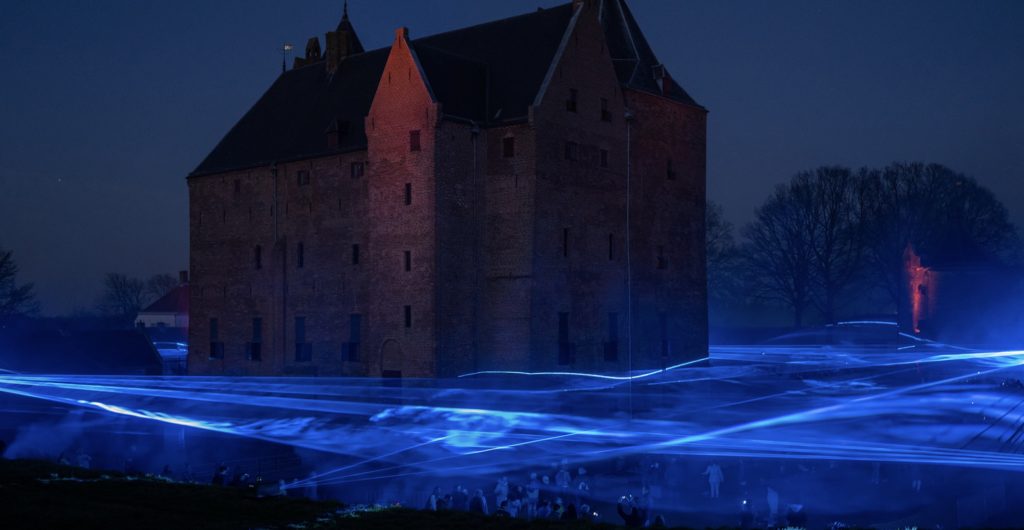
Studio Roosegaarde, Waterlicht, 2015, various locations. Studio Roosegaarde.
AC: That sounds impactful. Now, shifting to Dune, how does this exhibition incorporate the interplay between nature and technology and how can visitors interact with it?
DR: Dune is a fascinating installation that beautifully juxtaposes nature and technology. It’s a landscape of light made up of thousands of interactive LED light and sound fibers, creating a dynamic and engaging experience. These fibers respond to the motions of passing visitors. As you walk through, the light interacts with you in a playful manner, at times drifting away and then returning, like a dog occasionally listening and then losing focus. This element of unpredictability adds a delightful fuzziness to the experience, highlighting the profound connection between individuals and their impact on the environment. The installation encourages participation rather than mere observation, emphasizing the symbiotic relationship between humans and the world around them. Dune also invites tactile interaction, further reinforcing the notion that the art truly comes to life through the active engagement of the participants.
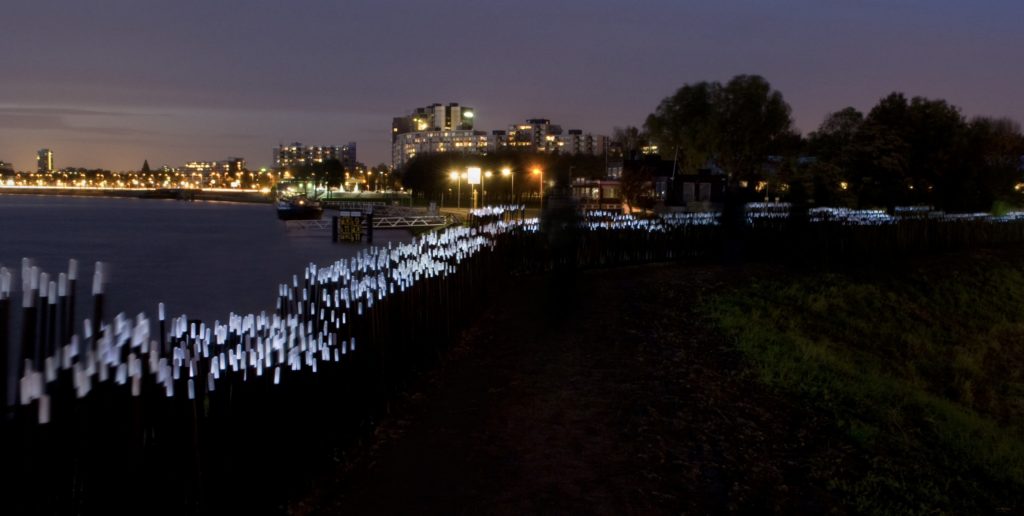
Studio Roosegaarde, Dune, 2006-2023, various locations. Studio Roosegaarde.
AC: It’s incredible how both installations offer such thought-provoking experiences. Can you share more about the specific dates and locations where visitors can witness Waterlicht and Dune in Tampa?
Cassie Greatens: Certainly! Dune will be on display at Sparkman Wharf from October 6 to 29, allowing visitors to interact with the exhibit free of charge from Thursday to Sunday, starting at 11 a.m. On the other hand, Waterlicht will grace Water Street on October 27, 28, and 29, starting at 8 p.m. each night, covering an expansive area of approximately 19,600 square feet. Attendees also have the opportunity to purchase tickets for premium seating at participating restaurants along Water Street to immerse themselves fully in the art display.
AC: Cassie, how does Waterlicht align with the vision and goals of your organization in terms of community engagement and promoting art?
CG: Waterlicht perfectly aligns with our vision of community engagement and promoting art. Our organization aims to make art accessible to everyone and break down traditional barriers that may limit people from engaging with it. Waterlicht achieves this by being a public art installation, free for all to experience. It brings together people from diverse backgrounds, ages, and interests, fostering a sense of community and wonder. It’s an example of how art can bridge gaps and connect people. Waterlicht offers a unique experience that engages the audience on multiple levels. It blends technology and art in a way that captivates and educates. For many, it might be their first interaction with this kind of immersive technological art. It’s a beautiful introduction to the possibilities of combining technology with artistic expression. By sparking curiosity and wonder, Waterlicht encourages people to explore the intersection of art and technology, potentially fostering new interests and opening up new experiences.
In our local district, Water Street Tampa, we’ve been running an annual Arts in Motion event. The core idea is to merge arts, science, and technology and showcase their interconnectedness. Last year’s collaboration with Refik Anadol delved into wind patterns through his artwork. This year, we’re focusing on water, aiming to highlight the various elemental facets and their intertwining with art. For us, it’s not just about art; it’s about community and the heartbeat of Water Street Tampa. We draw inspiration from the long-standing influence of Studio Roosegaarde, attracting massive crowds to their exhibits, fostering art awareness, and bringing together diverse demographics. The patterns and significance of water serve as a focal point, captivating different age groups — from five-year-olds to eighty-year-olds — embodying the beauty of art in its ability to unify and inspire awe.
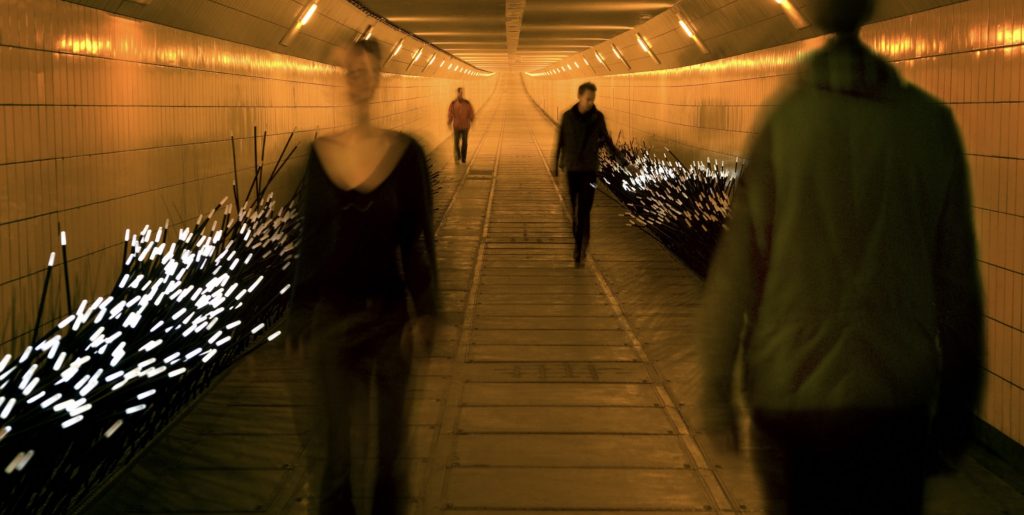
Studio Roosegaarde, Dune, 2006-2023, various locations. Studio Roosegaarde.
AC: Daan, could you shed some light on how you integrate technology and sustainability into your art, particularly focusing on the Waterlicht project?
DR: Waterlicht is a great example of integrating technology and sustainability. The LEDs used in the installation are energy-efficient, and the project emphasizes the need for sustainable practices in our cities. It encourages discussions about how we can integrate beauty and art into the urban landscape while being environmentally conscious. Technology allows us to create these immersive experiences while keeping sustainability at the forefront, pushing boundaries and encouraging a rethinking of our relationship with the environment.
AC: Daan and Cassie, what do you hope the social impact of Waterlicht will be in Tampa and potentially in other locations where it may be exhibited?
DR: Our hope is that Waterlicht will inspire people to reflect on their relationship with water and their environment. We want to create a moment of awe and contemplation, connecting people to the beauty of water while reminding them of the challenges we face, particularly in the context of climate change and rising sea levels. We aim to encourage dialogue and action toward a more sustainable future.
CG: Additionally, we hope that the social impact will extend to the community, promoting inclusivity and a sense of togetherness. We want people to feel connected to the art, the environment, and each other. By providing a space for shared experiences, Waterlicht can foster a sense of unity and appreciation for art and technology.
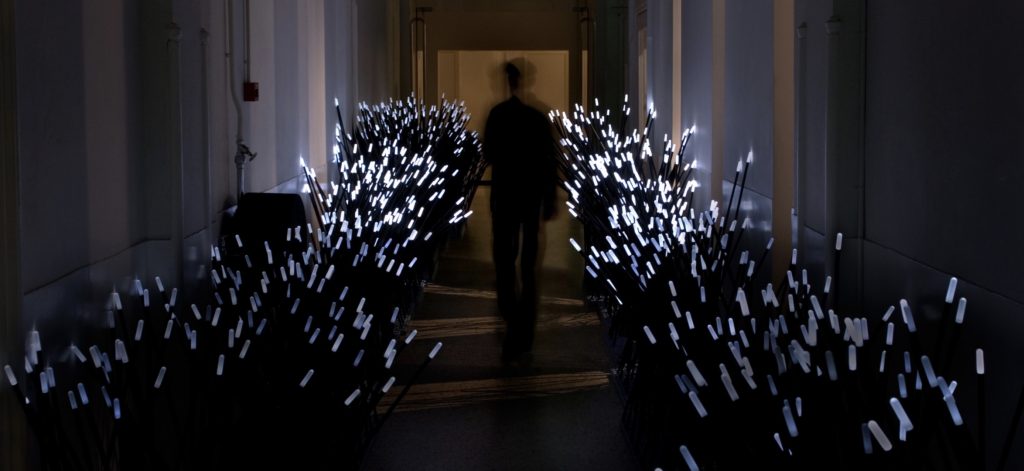
Studio Roosegaarde, Dune, 2006-2023, various locations. Studio Roosegaarde.
AC: That’s fantastic. It’s evident that both installations will be accessible to a wide audience in Tampa. Could you tell us more about Water Street Tampa and how it aligns with the themes of sustainability and innovation in these exhibitions?
CG: Water Street Tampa, known for its commitment to sustainability, wellness, and cutting-edge technology, is the perfect setting for these thought-provoking art installations. As the first WELL Certified Community in North America and achieving LEED Silver certification for LEED® for Neighborhood Development, the neighborhood embodies a forward-thinking approach. By showcasing Waterlicht and Dune, Water Street Tampa emphasizes its dedication to environmental awareness and sustainability while encouraging the community to engage with and reflect upon critical issues facing our world.
AC: Daan, as an artist, how do you perceive the role of AI and technology in the future of art, and how do you balance it with the human touch and artistic expression?
DR: Technology is a tool, an extension of human creativity. It offers us new ways to explore and express our ideas. I see AI and technology as part of the artist’s palette, just like any other medium. However, the essence of art remains in the human creativity, the intention, and the emotions conveyed through the work. Balancing this involves using technology to enhance artistic expression while ensuring it doesn’t overshadow the human touch, emotion, and intent behind the art.
AC: Cassie, given the evolving landscape of art and technology, how do you envision integrating AI and similar technologies in future art projects to engage diverse audiences?
CG: We see AI and similar technologies as incredible tools to engage diverse audiences. They allow for personalized and interactive experiences, catering to varying interests and preferences. Future art projects could utilize AI to create dynamic and adaptive installations, providing a tailored experience for each individual. It’s about finding ways to leverage AI to enhance accessibility, inclusivity, and engagement, making art more interactive and appealing to a wider spectrum of people.
AC: That’s fantastic. Shifting gears a bit, Daan, your work often involves a blend of art, technology, and scientific research. Can you share how you find a balance between these elements in your projects?
DR: Finding the right balance between art, technology, and scientific research is crucial. Art is about emotion and expression, while technology and science provide the tools and framework to bring those emotions to life. Scientific research often informs the concepts, but it’s the artistic vision that guides the execution. My aim is always to create something aesthetically beautiful while utilizing technology and scientific principles to achieve that goal. The art must resonate with people on an emotional level, and that’s where the balance comes in. The existing linear thinking will not solve the global challenges we’re facing. We must sort of reconnect and create new neuron links in our heads to become future proof and this type of art has the power to support us.
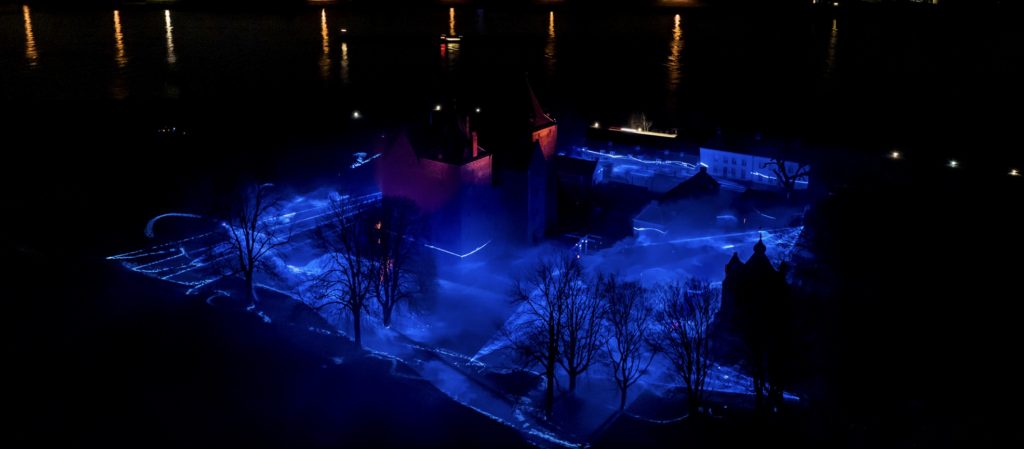
Studio Roosegaarde, Waterlicht, 2015, various locations. Studio Roosegaarde.
AC: Daan and Cassie, can you provide any insights into upcoming projects or initiatives you’re excited about or currently working on?
DR: We’re constantly exploring new ideas and pushing the boundaries of what’s possible. Our space waste project, addressing the issue of space junk, is an ambitious initiative in the works. We’re also working on making plants glow using innovative techniques. These projects showcase our ongoing commitment to addressing pressing issues and exploring the intersection of art, technology, and sustainability.
CG: As an art consulting firm, we have several exciting projects lined up for 2024. While I can’t provide specific details yet, we’re thrilled about collaborating with various artists and organizations to bring innovative and accessible art experiences to communities. Our goal is to continue breaking traditional norms and making art an integral part of people’s lives.
AC: Daan, you mentioned working currently on an issue addressing space waste. Can you tell us more about this project and how you’re planning to tackle the issue of space debris?
DR: Space waste is a significant concern, and our project involves tackling this issue by capturing and upcycling the space junk currently orbiting our planet. We’re working with space agencies like NASA and ESA to develop methods to clean up this debris and repurpose it into something useful. It’s about finding innovative and sustainable solutions to reduce the environmental impact of our activities beyond Earth.
AC: Thank you, Daan and Cassie, for providing valuable insights into your collaborative project and the future of art and technology. We look forward to witnessing the impact of Waterlicht and your upcoming initiatives. It’s been a pleasure speaking with both of you.
DR and CG: Thank you. The pleasure is ours.
Dune will be on view at Sparkman Wharf from October 6–29, 2023. Waterlicht will be on display on Water Street from October 27-29 (both locations in Tampa, Florida, USA). Click here for further details regarding both installations.
